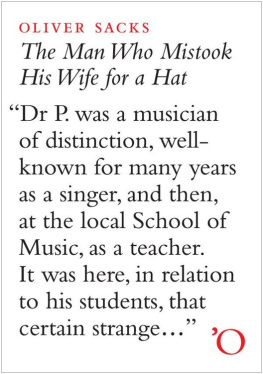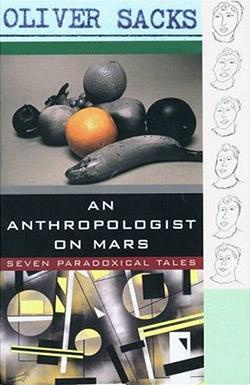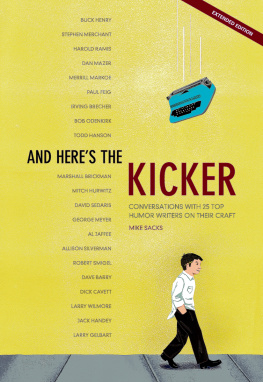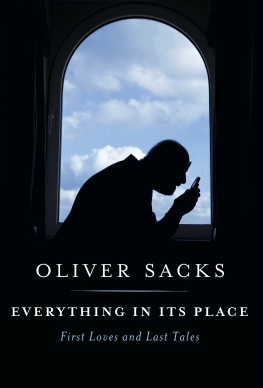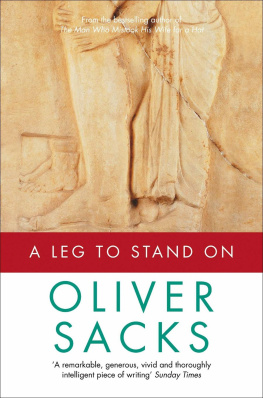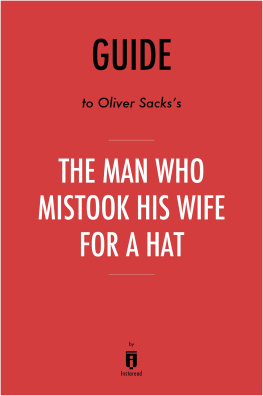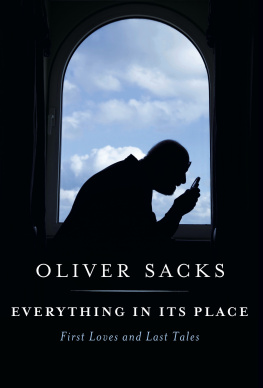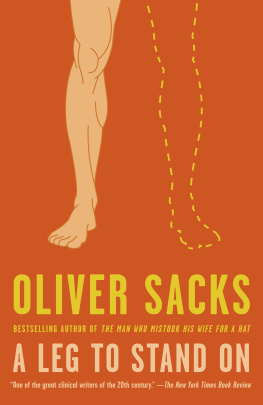Sacks - The man who mistook his wife for a hat and other clinical tales
Here you can read online Sacks - The man who mistook his wife for a hat and other clinical tales full text of the book (entire story) in english for free. Download pdf and epub, get meaning, cover and reviews about this ebook. City: Brantford;Ontario, year: 2010;2017, publisher: Odyssey Editions;W. Ross MacDonald School Resource Services Library, genre: Art. Description of the work, (preface) as well as reviews are available. Best literature library LitArk.com created for fans of good reading and offers a wide selection of genres:
Romance novel
Science fiction
Adventure
Detective
Science
History
Home and family
Prose
Art
Politics
Computer
Non-fiction
Religion
Business
Children
Humor
Choose a favorite category and find really read worthwhile books. Enjoy immersion in the world of imagination, feel the emotions of the characters or learn something new for yourself, make an fascinating discovery.
The man who mistook his wife for a hat and other clinical tales: summary, description and annotation
We offer to read an annotation, description, summary or preface (depends on what the author of the book "The man who mistook his wife for a hat and other clinical tales" wrote himself). If you haven't found the necessary information about the book — write in the comments, we will try to find it.
The man who mistook his wife for a hat and other clinical tales — read online for free the complete book (whole text) full work
Below is the text of the book, divided by pages. System saving the place of the last page read, allows you to conveniently read the book "The man who mistook his wife for a hat and other clinical tales" online for free, without having to search again every time where you left off. Put a bookmark, and you can go to the page where you finished reading at any time.
Font size:
Interval:
Bookmark:
Who
Mistook
His Wife
for
a Hat
OLIVER SACKS
To Leonard Shengold, M.D.
The last thing one settles in writing a book, Pascal observes, is what one should put in first. So, having written, collected and arranged these strange tales, having selected a title and two epigraphs, I must now examine what I have doneand why.
The doubleness of the epigraphs, and the contrast between themindeed, the contrast which Ivy McKenzie draws between the physician and the naturalistcorresponds to a certain doubleness in me: that I feel myself a naturalist and a physician both; and that I am equally interested in diseases and people; perhaps, too, that I am equally, if inadequately, a theorist and dramatist, am equally drawn to the scientific and the romantic, and continually see both in the human condition, not least in that quintessential human condition of sicknessanimals get diseases, but only man falls radically into sickness.
My work, my life, is all with the sickbut the sick and their sickness drives me to thoughts which, perhaps, I might otherwise not have. So much so that I am compelled to ask, with Nietzsche: As for sickness: are we not almost tempted to ask whether we could get along without it?and to see the questions it raises as fundamental in nature. Constantly my patients drive me to question, and constantly my questions drive me to patientsthus in the stories or studies which follow there is a continual movement from one to the other.
Studies, yes; why stories, or cases? Hippocrates introduced the historical conception of disease, the idea that diseases have a course, from their first intimations to their climax or crisis, and thence to their happy or fatal resolution. Hippocrates thus introduced the case history, a description, or depiction, of the natural history of diseaseprecisely expressed by the old word pathology. Such histories are a form of natural historybut they tell us nothing about the individual and his history; they convey nothing of the person, and the experience of the person, as he faces, and struggles to survive, his disease. There is no subject in a narrow case history; modern case histories allude to the subject in a cursory phrase (a trisomic albino female of 21), which could as well apply to a rat as a human being. To restore the human subject at the centrethe suffering, afflicted, fighting, human subjectwe must deepen a case history to a narrative or tale; only then do we have a who as well as a what, a real person, a patient, in relation to diseasein relation to the physical.
The patients essential being is very relevant in the higher reaches of neurology, and in psychology; for here the patients personhood is essentially involved, and the study of disease and of identity cannot be disjoined. Such disorders, and their depiction and study, indeed entail a new discipline, which we may call the neurology of identity, for it deals with the neural foundations of the self, the age-old problem of mind and brain. It is possible that there must, of necessity, be a gulf, a gulf of category, between the psychical and the physical; but studies and stories pertaining simultaneously and inseparably to bothand it is these which especially fascinate me, and which (on the whole) I present heremay nonetheless serve to bring them nearer, to bring us to the very intersection of mechanism and life, to the relation of physiological processes to biography.
The tradition of richly human clinical tales reached a high point in the nineteenth century, and then declined, with the advent of an impersonal neurological science. Luria wrote: The power to describe, which was so common to the great nineteenth-century neurologists and psychiatrists, is almost gone now.... It must be revived. His own late works, such as The Mind of a Mnemonist and The Man with a Shattered World, are attempts to revive this lost tradition. Thus the case-histories in this book hark back to an ancient tradition: to the nineteenth-century tradition of which Luria speaks; to the tradition of the first medical historian, Hippocrates; and to that universal and prehistorical tradition by which patients have always told their stories to doctors.
Classical fables have archetypal figuresheroes, victims, martyrs, warriors. Neurological patients are all of theseand in the strange tales told here they are also something more. How, in these mythical or metaphorical terms, shall we categorise the lost Mariner, or the other strange figures in this book? We may say they are travellers to unimaginable landslands of which otherwise we should have no idea or conception. This is why their lives and journeys seem to me to have a quality of the fabulous, why I have used Oslers Arabian Nights image as an epigraph, and why I feel compelled to speak of tales and fables as well as cases. The scientific and the romantic in such realms cry out to come togetherLuria liked to speak here of romantic science. They come together at the intersection of fact and fable, the intersection which characterises (as it did in my book Awakenings) the lives of the patients here narrated.
But what facts! What fables! To what shall we compare them? We may not have any existing models, metaphors or myths. Has the time perhaps come for new symbols, new myths?
Eight of the chapters in this book have already been published: from Migraine. The remaining twelve pieces are unpublished and entirely new, and were all written during the autumn and winter of 1984.
I owe a very special debt to my editors: first to Robert Silvers of the New York Review of Books and Mary-Kay Wilmers of the London Review of Books; then to Kate Edgar, Jim Silberman of Summit Books in New York, and Colin Haycraft of Duckworths in London, who between them did so much to shape the final book.
Among my fellow neurologists I must express special gratitude to the late Dr James Purdon Martin, to whom I showed videotapes of Christina and Mr MacGregor and with whom I discussed these patients fully, for many years when he was a child.
I wish to acknowledge the selfless help and generosity of the patients (and, in some cases, the relatives of the patients) whose tales I tell herewho, knowing (as they often did) that they themselves might not be able to be helped directly, yet permitted, even encouraged, me to write of their lives, in the hope that others might learn and understand, and, one day, perhaps be able to cure. As in Awakenings, names and some circumstantial details have been changed for reasons of personal and professional confidence, but my aim has been to preserve the essential feeling of their lives.
Finally, I wish to express my gratitudemore than gratitudeto my own mentor and physician, to whom I dedicate this book.
O.W.S.
New York
February 10, 1985
To talk of diseases is a sort of Arabian Nights entertainment.
W ILLIAM O SLER
The physician is concerned [unlike the naturalist]... with a single organism, the human subject, striving to preserve its identity in adverse circumstances.
I VY M C K ENZIE


Font size:
Interval:
Bookmark:
Similar books «The man who mistook his wife for a hat and other clinical tales»
Look at similar books to The man who mistook his wife for a hat and other clinical tales. We have selected literature similar in name and meaning in the hope of providing readers with more options to find new, interesting, not yet read works.
Discussion, reviews of the book The man who mistook his wife for a hat and other clinical tales and just readers' own opinions. Leave your comments, write what you think about the work, its meaning or the main characters. Specify what exactly you liked and what you didn't like, and why you think so.

